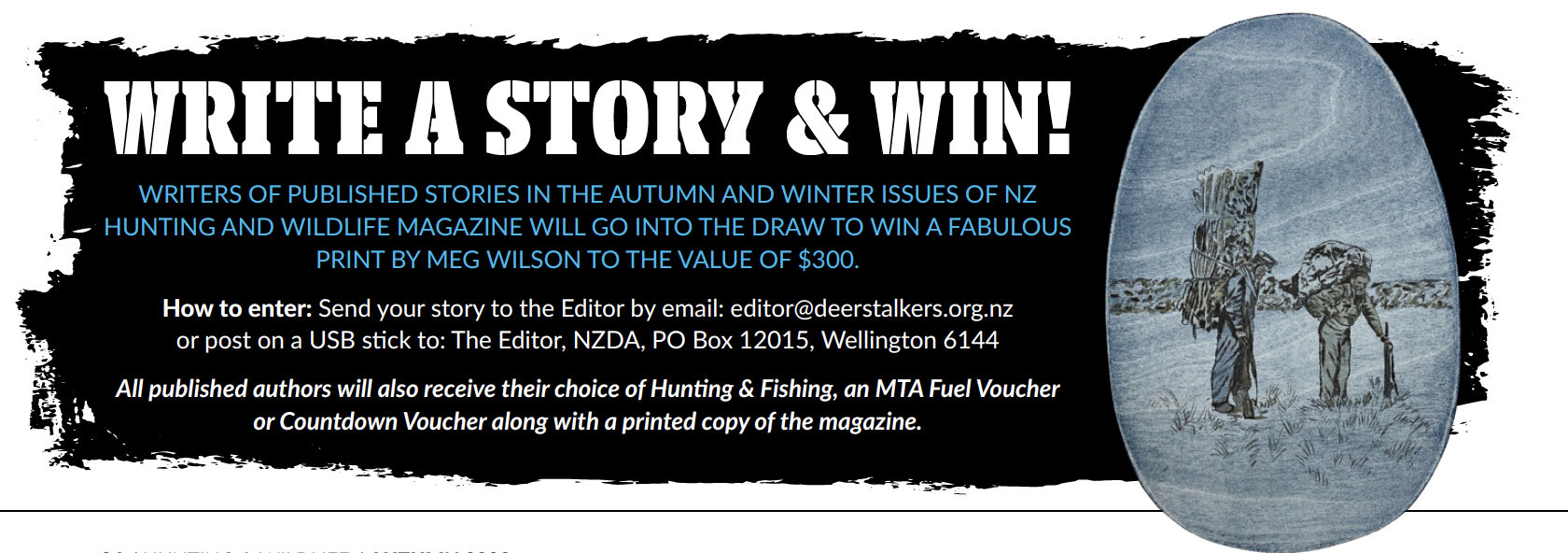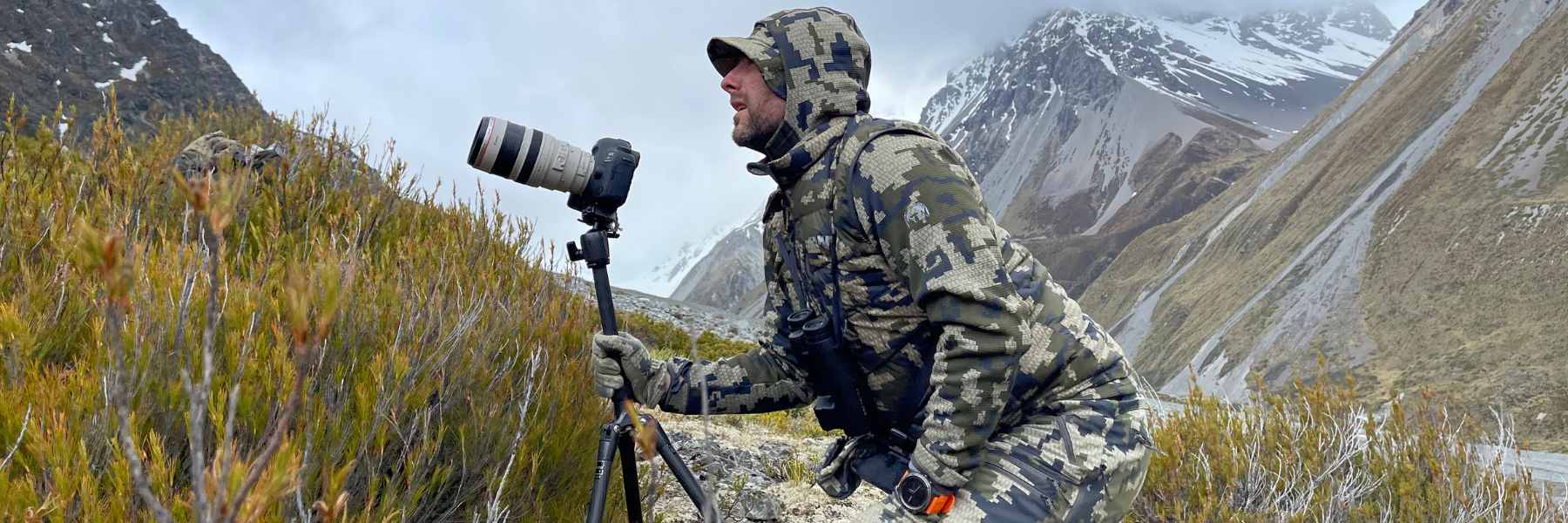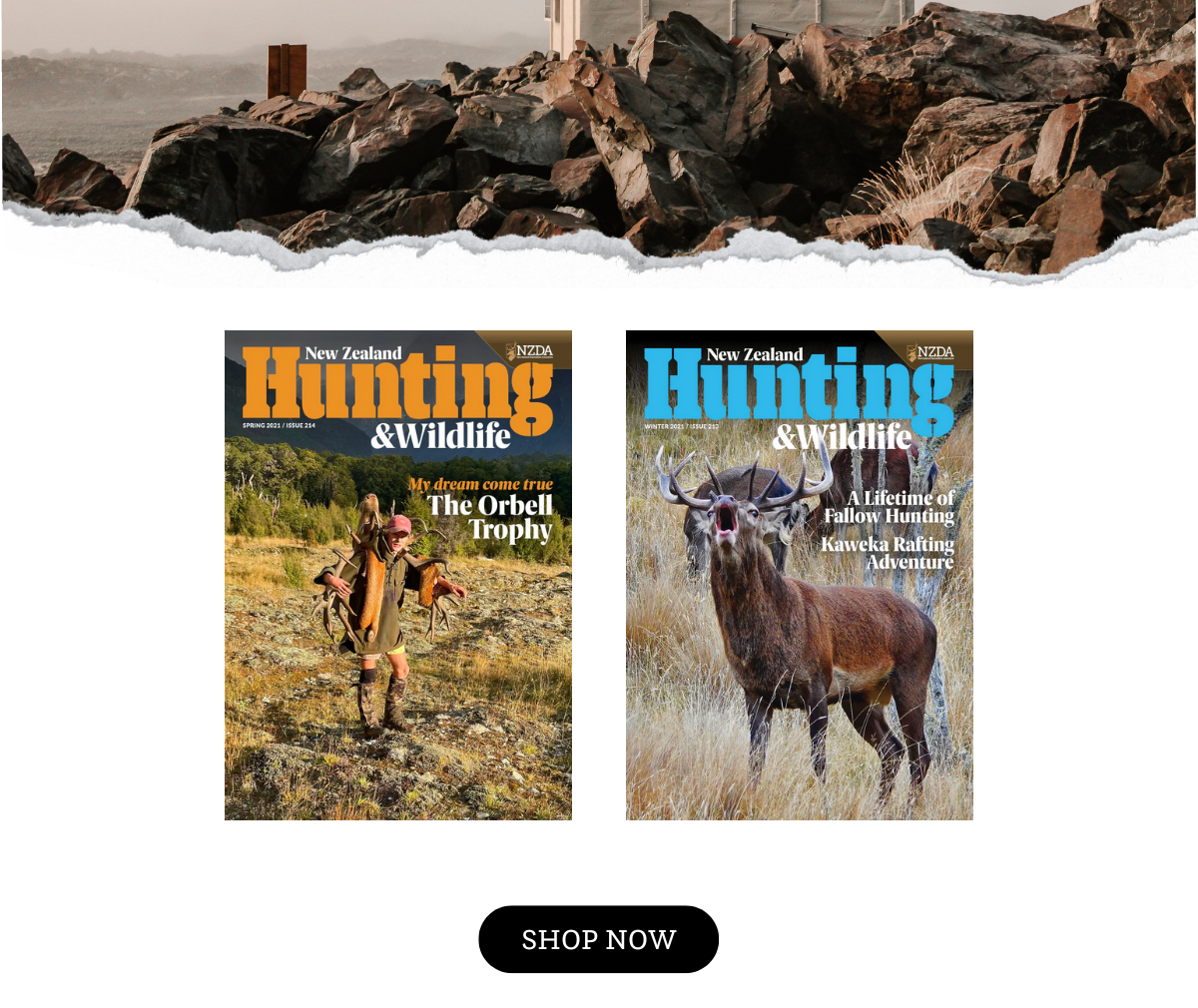Otago Branch Lowvember Tahr Hunt
1 February
Hunting and Wildlife Magazine - Issue 217 Winter
Words By: Selwyn Smith
I glanced down at the notification appearing at the bottom of my screen. The headline read (yet another) Covid Cancellation. I clicked on the email link to see it was a real 'doozey'. I’d booked leave and several mates from around the country were to attend this festival. Expletives followed as I digested the update. The South Island events sector was being slammed. We had no Covid at the time, but committees around the country had no confidence in the outlook to commit to public events under the Level 2 system.
I sent a few emails to the crew - with predictive responses. They would postpose their flights until next year. The window was now wide open to get an alpine NZDA Otago branch club hunt off the ground.
More emails flew and the die was cast. We had cancelled the last three club hunts due to extreme weather events – I was determined to get this one off the ground, despite the increasingly frustrating Covid fog that we were operating under.
Choppers were booked and notification of the event sent to all club members. With 8 seats available across the two choppers, balloting began. Filling the 8 seats available was relatively seamless despite the usual last-minute dropouts post ballot.
Sunday night saw us driving to the pickup spot and enjoying a BBQ and craft beer tasting while we swapped notes, studied maps, and discussed last minute plans.
Weather during the previous week had been lumpy with a reasonable sized snow fall across the wider Mt Cook region. Scanning the big valley we were destined for showed snow down to about 1400m. With relatively settled weather predicted for the next 4 days, anticipation was high as we discussed the importance of spending day-one glassing as much country as possible before gaining any serious height. Many of the crew had not been Tahr hunting before, and I knew full well how easy it was to get pre-occupied with the first sizeable animal sighted. Use the first day as a recce’!
The Weigh In
First light saw us at lined up at the hanger for the moment to truth. With a weight limit of 550kg including gear per chopper load, it was critical that everyone met the weight limit. Douglas had cunningly anticipated that Kate would be under her allotted weight, and he was correct, allowing him to take a few extra home comforts. Douglas, Kate, Karan & Mike were flying into the hut in the lower country. Myself, Jack, Lucas & Sam were fly camping towards the top end of the valley in some more challenging terrain.
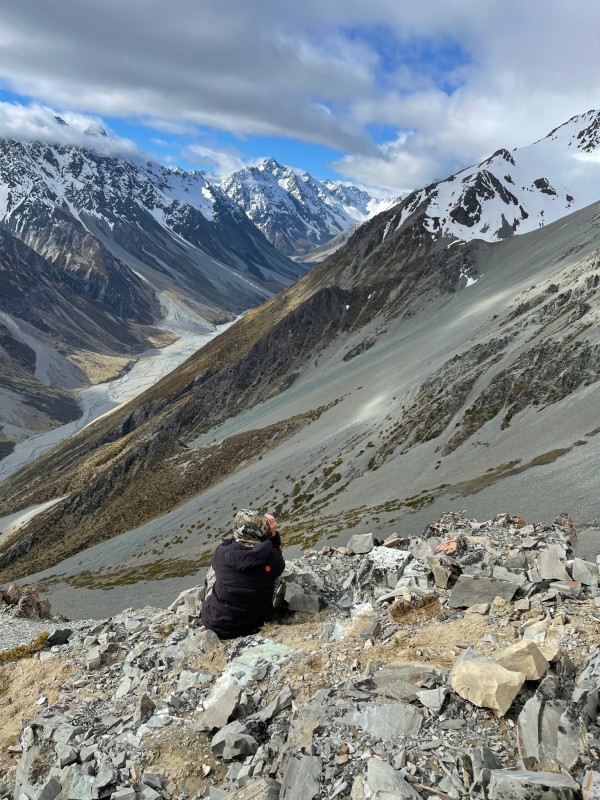
Day 1
A smooth flight in allowed us to survey the tops on the way past the hut. Tahr were seen at around 1800m – incredibly encouraging as we were unsure if any were left after the Tahrmageddon culls over autumn and winter.
We had gear assembled and camp set up within the hour. Bipods’, camera’s, ammo, down jackets and lunch were packed for the day. Lucas had managed to get all his gear for the week into a 90L Kuiu pack, no mean feat given the array of gadgets and paraphernalia he continued to pull out for our first assault. He was quickly named Gadget Man for the gear he continued to unpack, including a thermal monocular and drone!
Packs donned, we headed up-valley to survey unknown country. Not even five minutes into the first river flat system and whammo - gear failure. My favourite walking pole would no longer hold its extension, slipping with every step. This caused numerous descriptive’s as a walking pole is a real game changer on dicey slopes. Some detailed discussion ensued as the predictable jibes started kicking in.
" Don’t tell me...made in ……””?
"Why yes, what are the odds....."
"Hope you didn't pay actual money for that oversized fly swat''?
This is the deluxe 'swat'...and was the princely sum of $7.95. At only 5 years old, I haven't quite got my money's worth yet as it really should be good for another 5 years..."
The pole told otherwise of course...Gadget Man took great delight in pulling out his skeleton knife and unrolled about 30cm of industrial strength duct tape he'd wrapped around the blade. We joked that the tape was worth more than the pole, and that the pole value had now more than doubled. Despite the ribbing over the cheap-ass pole failure, Lucas's quick-fix survived another 3 solid days of clambering around the steep stuff. Serious tape indeed!
The First Sighting
The first gully system saw us glassing both sides of the valley. It wasn't long before I spotted numerous Tahr dotted around 1600m - the light-coloured spring coats of the nannies and juveniles making them relatively easy to spot against the dark shade of the terraced rock systems. Lucas & Sam were able to get their first look at Tahr and soon had their eye in on other Tahr dotted across the face to our north. The instructions to note their location and carry on up-valley were heeded as the clear focus for the day was on surveying the country and locating accessible terrain holding bull Tahr.
We continued to find pockets of animals at 1600-1900 metres, many of which were in country too big to safely navigate. Excitement continued to build throughout the day as the country continued to grow. Sam was eager to gain some height and crossed the river to navigate a creek system leading up to a hidden snow-covered saddle. We continued up-stream.
Jack made good use of his Nikon 900 camera and Manfrotto tripod- getting some great footage of animals and enabling us to better discern horn and hook length.
Lucas headed back about half-way up the valley, leaving myself and Jack to continue north. Mid-afternoon and we finally saw a bull worthy of closer inspection. The much darker colouration of the 4 year+ bulls clearly defined them as more mature than the 2-3 year old bulls with mid-brownish coats that we'd been glassing until now. Discussion flowed on calculating horn length on the hoof and the Nikon footage was poured over to critique length and width. This animal was out of reach and would have to wait until tomorrow.
Read the Wind!
Our trek back to the hut saw us glassing the big bluff and gully system where we'd first encountered reasonable numbers earlier in the day. It was now around 5pm and animals were coming off the hill. We saw a small mob meander down within 500m of us - we crept forward to a tussock mound to get a better look. While none of the animals were of any trophy note, we decided to take one for meat. 355m was the reading as I gently closed the bolt on the Remington 700 Titanium. At just 3.3kg's all up including suppressor and chambered into one of my favourite short action rounds - the 7mm Remington Short Action Ultra Magnum, this is a serious lightweight mountain goat rig. The animal was quartering away as I settled the crosshair on the shoulder point. I squeezed off only to see the half-dozen animals in the mob bolt at high speed across the face and over the lip. We reviewed the video footage to see that the projectile had just missed the very front of the shoulder by a mere whisker- I'd seriously underestimated the stiff breeze bowling up the valley. The Bull suddenly re- appeared at the top of the next terrace. Jack chambered a round in his 300 WM, dialled for the 550m gap and squeezed off. The dust cloud behind confirmed a miss - footage once again confirmed failing to allow sufficient windage into the breeze. Lessons learnt!
Just 600m from camp and another 2-year-old bull materialised towards the head of a waterfall. Perched on the ledge, the crosshairs settled on his right shoulder as he turned side on. Windage adjusted, I squeezed off. The bull tumbled off the ledge and landed in a tricky spot. Jack flew up the chute and eventually found the animal - leveraging it to the ledge and heaving it over. We joked that Lucas would be a big fan of Tahr Mountain Oysters given his fascination with exotic food. Served cold, these would invoke an interesting reaction. In our haste to get this animal butchered and back to camp before dark, the prized 'Oysters' remained perched on a tussock.
Back at camp we swapped notes on the day. Sam had first rights with a young Tahr he'd shot thinking it was a much larger animal until he had it on the deck. Irrespective, Sam's excitement continued when he spotted a sizeable bull Tahr toward the end of the day - it would have to wait. Lucas's custom long range .308 remained unfired as he was quite contempt taking in the awe of the big bluff systems and making full use of his high-end DSLR – snapping some outstanding footage of Tahr at home in serious Southern Alps terrain.
I'd volunteered to bring the lone gas cooker - advising the rest of the group to leave theirs at home to avoid doubling up unnecessarily. We were all digesting the finest freeze dried food for the week so a simple water boiling cooker was all that was required across the group. 30 seconds after unpacking the collapsible Alpine stove, the gas lead snapped. Gear failure # 2 for the day. We would be doing it tough on stone-cold recon meals. Luckily the rest of the crew ignored my instructions and had all packed a micro or liquid fuel stove. I put Lucas’s LPG MSR to good use for the rest of the week.
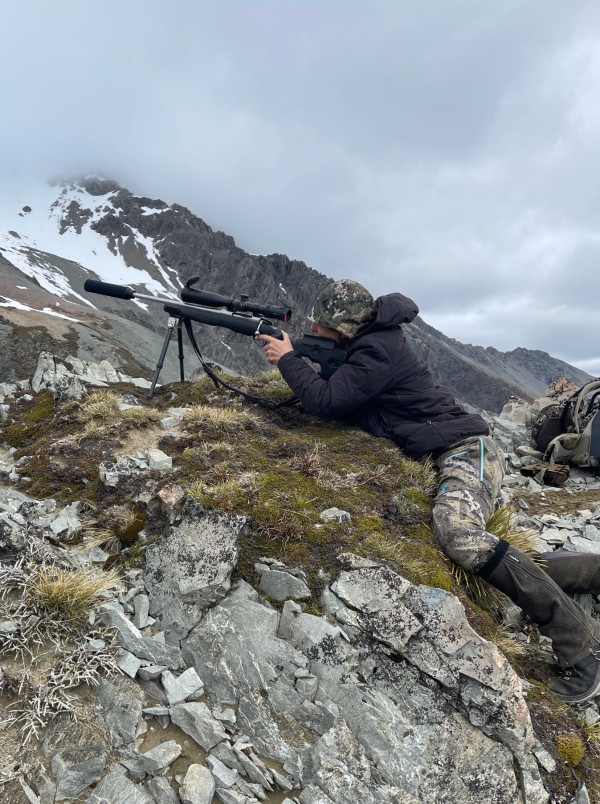
Day 2
Tuesday saw us filing off down-stream to review the lower reaches. We were around 10 kilometres from the other team’s camp so we remained conscious of a likely boundary line. Animal sightings were sparse, with the odd lone juvenile dotted around the base of moderate bluffs. Sam had studied the block map in detail and made the call to cross the river again and head up a steepish chute to the neighbouring catchment of the day before. The rest of us trudged back to camp for an early lunch and then back up stream.
The overnight snow resulted in a seriously cold wind whipping up the valley. I had multiple thermal layers on including down and windproof layers + 2 x beanies to keep the cold at bay while we spent the afternoon glassing. Late afternoon and just 1.3km's from camp, we finally spotted a standout bull. Out with the Nikon to confirm and gear was readied. Jack dallied up (another 550m shot - DeJa’Vu?) while I ran the camera. Lucas also steadied his DSLR. Jack noted the stiff Southerly gusts and used his crosshair windage dot to adjust. Squeezing off, the bull immediately shot into top gear and bolted over the ridge onto the next bluff system. He didn't slow down for a follow up. This was our best chance of a quality trophy and we had nothing to show for 2 solid days. The camera footage again showed a lack of windage estimation. Jack was scratching his head with the miss.
A fruitless afternoon saw us back at camp to sample Lucas's Freeze Dry Strawberry Ambrosia that he had talked up. My remarks were layered in scepticism on the trudge back to camp. On first bite, I quickly became a full convert! This was extreme decadence and quite frankly one of the best deserts that good (or bad) money could buy.
10pm, sitting in a tussock highchair digesting the day over some beers, we waited for Sam to return. We cranked up the UHF and thankfully he was within range. Half an hour later we could see Sam's headlamp appearing over the peak on the far side of the valley. He reminded us of the two bull Tahr he had shot, butchered in his pack. My immediate concern was the bluffed, steep decent he had to navigate, in the dark with a heavy load. A recipe for a turned ankle or serious fall. Thankfully Sam is a strapping, fit young lad with sure-footedness to match. Back at camp he pulled out his camera to highlight the hidden valley he'd traversed while we measured his two heads at a touch over 11". He'd been knee deep in snow for a fair bit of the day - how he wasn't exhausted after a big 15-hour day is tribute to his aerobic stamina. Sam's nickname morphed into Mountain Man after his heroic efforts.
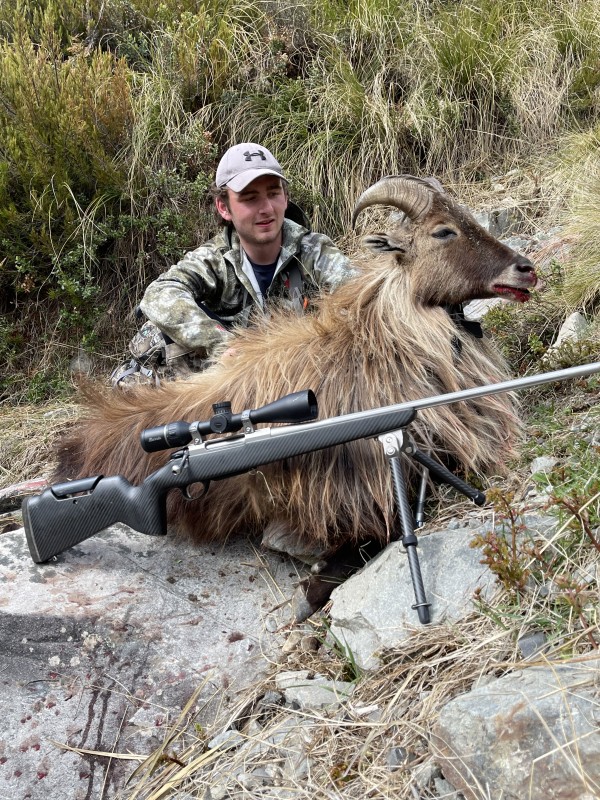
Day 3
The penultimate day saw a leisurely start as the three lads wandered downstream to test Lucas's ultralight fly rod. The rod and reel used the latest in nano technology and weighed little more than a handful of wine corks. The few trout sighted were better educated than the fisherman and survived unscathed. A late brunch saw us leaving camp around 2pm - the plan was to make full use of 'Lowvember' (when bulls come down low to get the early spring growth) and be in prime position when the big bulls dropped altitude for the evening. It was about now that Jack had an epiphany. Studying his elevation and windage turrets before heading off, he noticed his windage turret had been wound well off-zero. The turret had been a victim of Velcro-grab while strapped to his pack the day before - no wonder his windage was so far off.
We decided to head north up the river flat and get as much glassing time in across the river - apart from Sam, this section was relatively new territory. We'd only gone a kilometre downwind when Sam spotted a mob on the opposite face. Within seconds, I locked eyes on a good bull below the main mob. This group was a mere 520m away, straight up the main gully. Our strategy to head out late was really paying dividends. No need for the Nikon - the clarity of my Zeiss 10x40's showed some pretty good hooks with bases to match. I snuck forward to a largish rock to get a solid rest. With the Harris bipod steadied and the vertical crosshair levelled, I closed the bolt and settled the crosshairs on the bulls leading shoulder, waiting for him to turn side on. The mob continued to graze, unaware. The bull gradually moved down the slope, tilting sideways. Squeezing the trigger, he collapsed, sliding down the slippery tussock face. The mob erupted at the shot and another bull of equal size and stature took off from the rest of the group and bolted downwind. I glanced back to see Jack behind me, rifle lining up. He fired. The bull, hit hard, charged back toward the main mob. I followed his movement in the scope. As he stopped to drop down a bank, I squeezed off. Jack's shot echoed at the same time and the Bull dropped out of sight.
Sam & Lucas, primed after the action that had just unfolded, decided to head downstream to check out a neighbouring chute. Jack & I surveyed the river and discussed access points. While only waist deep, the flow was swift and somewhat dicey. We agreed on a reasonable access point then put some of our NZDA Otago Branch Hunts Course river crossing training from years gone by to great effect - linking arms between our respective pack straps to ensure a rock steady approach.
We soon found Jack's bull folded amongst the Matagouri under a bank. The tape measure was immediately whipped out and the magic 12" number dutifully celebrated. My bull was a couple of hundred metres south and was easily spotted from a high vantage point. Again, the tape made it to the magic 12" figure. A stunning dual-result late on the last day.
Sam & Lucas arrived back at camp on last light - animals sighted but neither managed to get a bead on them. A celebratory fry-up of Tahr backsteaks had Sam on culinary duties. His Coleman dual fuel stove and lightweight, pint-sized pan soon had us dining on some outstanding medium-rare eye fillet and backsteaks in no time. Coupled with some beers we topped off an outstanding few days.
Flying out the next morning, we arranged a debrief back at a local cafe before heading home to allow both camps to swap notes on the preceding few days, key learnings and relay the excitement of everyone's adventures. There was resounding and clear feedback across the team that a 'Lowvember' Otago Branch club hunt needs to be well and truly cemented as an annual event.
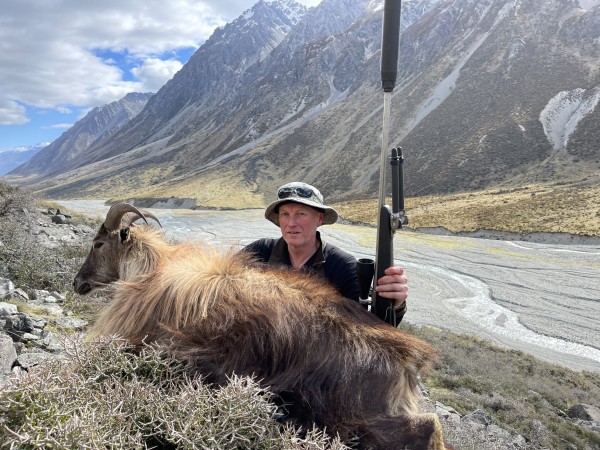
Write for Hunting and Wildlife
